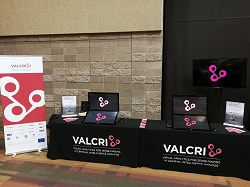Visual analytics for brighter criminal intelligence
Big data, its dizzying volumes of information flowing from multiple sources and the lack of perspective on these sources means it’s really difficult to make sense of information in moments of urgency. As Andrew Parker, Director of the MI5 once explained, ‘we only ever have fragments of information, and we have to try to assemble a picture of what might happen, based on those fragments.’ This problem started coming to light with the 9/11 terrorist attacks, and has been plaguing investigations up until the most recent attacks. However, a solution is now presenting itself. The VALCRI (Visual Analytics for Sense-making in CRiminal Intelligence analysis) project consortium is in the final development stages of a criminal intelligence analysis system based on visual analytics and cognitive engineering. ‘The cognitive engineering approach provided us with insights about how analysts think, rather than just what analysts do,’ explains Prof. William Wong, coordinator of VALCRI. ‘The idea is to tap into the right resources for each task: humans for reasoning and sense-making with ambiguity; and machines for the heavy-lifting, to search through millions of records distributed across many different databases and present semantically similar information within the same visual field of view.’ Concretely, cognitive engineering implies a workspace split into three parts: the Data Space, which enables the analyst to see what data they have and how they are related; the Analysis Space, to perform various computations in order to understand trends, patterns, relationships and other significant behaviours; and the Hypothesis Space, where the analyst collates, assembles the data and formulates hypotheses and arguments that they can test scientifically. The latter process, called storytelling, is particularly important. Prof. Wong compares it to archaeology: ‘Using fragments of broken pottery and other artefacts, then using their knowledge of the history of the time, archaeologists construct narratives that explain what society might have been like at the time,’ he explains. Relieving analysts To help analysts, the VALCRI team studied how they think and work, and quickly identified the finding and assembly of related or relevant information as a major issue. ‘Manually searching different databases for such information in the case of a simple crime requires an estimated 73 separate SQL queries. It can take three to five days,’ says Prof. Wong. With VALCRI, this process can be performed with a single click. The system uses dedicated engines to identify similarities, performs associative searching and comes up with reports in the same area and timeframe, but not necessarily of the same crime type. VALCRI even searches for possible associations between unconnected data to compare solved and un-solved crimes, which can prove very handy in quickly generating a list of potential suspects. Every aspect of VALCRI was designed with user-friendliness and efficiency in mind. The interaction design, for instance, is based on tactile reasoning – the direct manipulation of information objects in the user interface. As Prof. Wong explains: ‘We believe that when one is presented with a set of information that can be freely moved, manipulated, grouped and rearranged in a visuo-spatial manner, it helps discover meanings or relationships.’ The police analysts who could test VALCRI were impressed by this aspect, saying that it helped them develop, and maintain an overview of, their analytic process whilst keeping track of status, identifying oversights and remaining tasks. VALCRI also put emphasis on privacy protection. The data access control security software specifies which faces a user can or cannot see, whilst video anonymisation blurs out the faces of those specified. The consortium actually solved a common problem with security-related projects: the lack of realistic data. ‘We developed anonymised data based on over 1.5 million actual records from one of our police partners,’ says Prof. Wong. The dataset is currently been validated and – if proven impossible to de-anonymise – it will be released to the scientific and research community. By the end of June, Prof. Wong and his team intend to deliver an integrated, multi-function system at TRL-5. The VALCRI prototype in currently being deployed at the premises of the project’s police partners. ‘Current efforts are focused on ensuring an accurate ingestion of the data, and if time and resources permit, we hope to be able to demonstrate VALCRI’s capability to solve actual crime cases,’ Prof. Wong says.
Keywords
VALCRI, data visualisation, crime prevention, crime solving, police analysts, visual analytics, criminal intelligence, crime, cognitive engineering, storytelling



